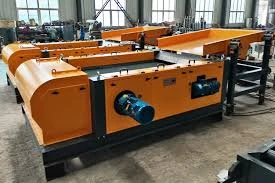

નવેમ્બર . 21, 2024 15:57 Back to list
How Does an Eddy Current Separator Work?
Eddy current separators are advanced devices used in a variety of industries for the efficient separation of non-ferrous metals from mixed waste or recyclable materials. The fundamental principle behind these separators is the induction of eddy currents in conductive materials when they are subjected to a changing magnetic field. This process allows for the effective separation of aluminum, copper, and other non-ferrous metals from non-metallic materials such as plastics and wood.
The Principle of Eddy Currents
The concept of eddy currents is rooted in electromagnetic theory. When a conductor, such as a piece of aluminum, moves through a magnetic field or when the magnetic field itself changes, it induces circulating currents within the conductor. These are known as eddy currents. The direction of these currents is such that they oppose the change in the magnetic field due to Lenz's Law, leading to the creation of a magnetic field that acts in the opposite direction to the original field.
In an eddy current separator, a rotating drum is equipped with magnets that create a strong magnetic field. When conductive materials pass through this field, eddy currents are induced, and the resulting magnetic field that is created interacts with the original field from the magnets. This interaction generates a repulsive force that effectively propels the conductive materials away from the flow of non-conductive materials.
The Separation Process
The separation process begins with the feed material being fed onto a conveyor belt that transports it towards the eddy current separator. The material generally consists of various types of waste or recyclable materials, including metals, plastics, and wood. As the mixed material reaches the rotating drum, the eddy current mechanism is activated.
When non-ferrous metals in the material pass through the magnetic field, they acquire a repulsive charge due to the induced eddy currents. As a result, these metals are propelled away from the conveyor belt and fall into a separate collection chute, often referred to as the non-ferrous metal outlet. Conversely, non-conductive materials, which do not induce eddy currents, continue to move forward along the conveyor belt and exit the separator as waste.
Advantages of Eddy Current Separators

Eddy current separators are highly efficient and effective tools for metal recovery and recycling. They offer a range of advantages over other separation techniques. One significant advantage is their ability to process mixed materials without needing complex pre-sorting. This makes them ideal for operations where the input materials are diverse and may include unwanted contaminants.
Additionally, eddy current separators can achieve high levels of metal recovery, often exceeding 90%, depending on the material characteristics and the design of the separator. This efficiency helps reduce the environmental impact of waste and enhances the recovery of valuable metals, contributing to sustainable practices in recycling.
Applications of Eddy Current Separators
Eddy current separators are widely used in many industries, including
1. Recycling They are essential in recycling facilities for the separation of aluminum and other non-ferrous metals from shredded cars, electronic waste, and other recyclable materials. 2. Mining In the mining sector, eddy current separators are employed to extract non-ferrous metals from ore or tailings, improving the overall yield from the extraction process.
3. C&D Waste Management Construction and demolition waste often contains valuable metals that can be recovered using eddy current separation, thereby reducing landfill volumes and promoting recycling.
4. Plastic Recycling Eddy current separators can also help in removing metal contaminants from plastic streams, ensuring cleaner plastic outputs for recycling.
Conclusion
Eddy current separators represent a clever application of electromagnetic principles to solve practical problems in waste management and recycling. By effectively separating non-ferrous metals from mixed materials, they play a crucial role in improving recycling efficiency and promoting sustainable practices in various industries. As technology continues to advance, the capabilities of eddy current separators are expected to expand, further enhancing their utility in an increasingly eco-conscious world.
Latest news
Troubleshooting Common Eddy Separator Problems
NewsJul.04,2025
The Role of Metal Recycling Plants in Circular Economy
NewsJul.04,2025
The Impact of Recycling Line Pickers on Waste Management Costs
NewsJul.04,2025
Safety Features Every Metal Shredder Should Have
NewsJul.04,2025
How Industrial Shredders Improve Waste Management Systems
NewsJul.04,2025
How Cable Granulators Contribute to Sustainable Recycling
NewsJul.04,2025